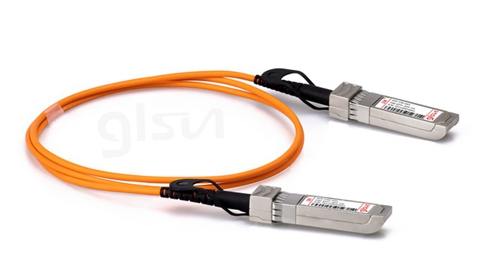Fiber Optic Tech
Direct Attach Cables (DAC) vs Active Optical Cables (AOC)
AOC cables and DAC cables are both pre-assembled optical transceiver modules with fiber patch cables, which are widely applied in data center, enterprise networks, high-performance computing connectivity, etc. Both are plug and play, and come in a variety of configurations to meet different network requirements. They are currently available in 10G SFP+, 25G SFP28, 40G QSFP+, and 100G QSFP28 data rates.
There are multiple factors (such as application, power consumption, transmission distance and budget) to consider when it comes to choosing network cabling. Knowing the advantages and disadvantages of each can help you make the correct choice.
AOC (Active Optical Cables)
Active Optical Cable (AOC) consists of multimode fiber optic cable connected to optical transceivers on both ends. It applies electrical-to-optical-electrical conversion on the cable ends to enable efficient and smooth data transmission without sacrificing compatibility with standard electrical interfaces.
Advantages of AOC Cables
1. Greater bandwidth: AOC cables can reach a throughput up to 40Gbps without any equipment upgrades.
2. Lightweight: For the same length, AOCs are about half the size and 1/4 the weight of DACs. It is the optimal solution if data centers don’t have enough space for cabling.
3. Strong Immunity to EMI: AOCs transmit signals via fiber, which does not conduct an electric current, thus making them immune to electromagnetic interference (EMI).
Disadvantage
Higher cost compared to DAC

DAC (Direct Attach Copper Cables)
DAC cables are made from twinax copper cables, terminated with modules that provide an electrical connection directly into active equipment. DACs are the most basic form of high speed direct attach cabling that are typically used on switches in data centers. AOC cables are always active, while DAC cables can either be passive or active. Passive DAC cables are used more frequently, providing optimal solution for short distance transmission.
Advantages of DAC Cables
1. High data rate: It can support data rate from 4Gbps to 10Gbps per channel.
2. Strong interchangeability: It is interchangeable and hot-pluggable with fiber optic modules.
3. Cost effective: It does not utilize a laser, which is the most expensive component in a transceiver; also, copper wiring is less expensive than fiber wiring.
Disadvantage
They are heavy and bulky, and are vulnerable to the effects of electromagnetic interference (EMI).
In general, DAC cables are applied for short-reach interconnection within 5 meters, and AOC cables are applied for 5-to-100-meter interconnections.



















